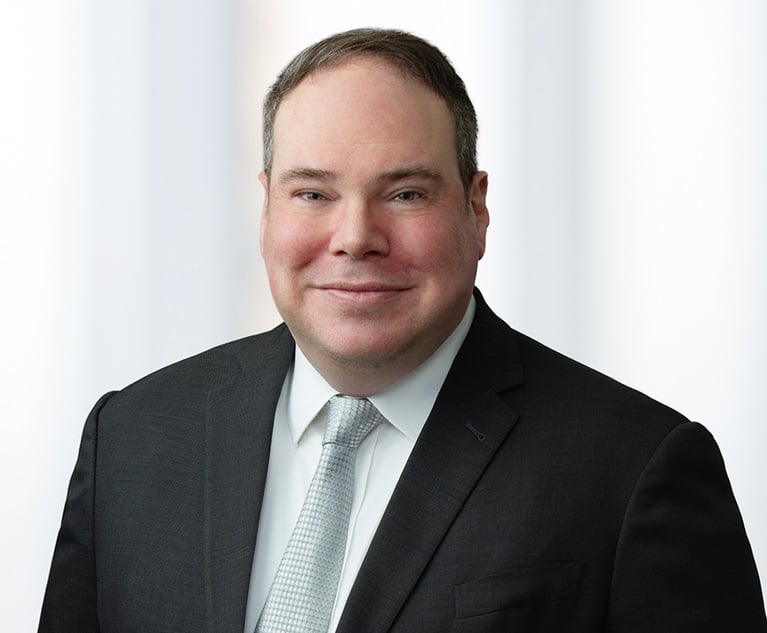How Do Midsize Firms Define a Good Year of Revenue Growth?
The 22 midsize firms (those between 50 and 200 lawyers) in this year's Am Law 200 combined to average 4.4% revenue growth in 2018.
November 07, 2019 at 02:00 PM
7 minute read
The original version of this story was published on Law.com
 wutzkohphoto/Shuttertock
wutzkohphoto/Shuttertock
The Am Law 100 collectively grew revenue by more than 8% in 2018, but not every firm in the country can bank on such lofty returns.
For midsize firms, revenue growth has been more modest in recent years, though a strong economy has helped keep it consistent. As they prepare to turn their attention to 2020 and seek to define the parameters of a good year of growth, many midsize firms are aiming for something more like a 5% improvement, according to interviews with law firm leaders and industry analysts.
"Demand growth has been flat to maybe 1% or 2%, depending on what you read," said Paul Hughes, managing partner of New Haven, Connecticut-based Wiggin and Dana, which has nearly 150 lawyers in eight offices. "So to do 4% or 5% (revenue growth) in the face of those headwinds is tough."
The 22 midsize firms (those between 50 and 200 lawyers) in this year's Am Law 200 combined to average 4.4% revenue growth in 2018, paced by Munger, Tolles & Olson's 16.5% jump.
The year before, midsize firms on the list averaged 5.7% growth.
Citi Private Bank's Law Firm Group, meanwhile, reported average revenue growth of 5.3% in 2018 for a sample of 59 midsize firms, 12 of which were in the Am Law 200. That same group reported 1.7% growth the year before, Citi said.
Ronald Shechtman, managing partner of 165-lawyer Pryor Cashman, said he would be pleased to see "something north of 5% in revenue growth" and to have most or all of it translate into increased profits.
Bob Baradaran, managing partner of Greenberg Glusker, a single-office firm with roughly 100 lawyers in Los Angeles, said that in his six years leading the firm, the strong post-recession economy has helped it land right near its year-over-year revenue growth targets. He said there are four main levers a firm can pull in aiming to achieve revenue growth: rate increases, lateral recruiting, cross-marketing clients and the business development of existing attorneys.
"It depends, in a given year, which ones you're more active or successful in firmwide," he said.
Rate increases have been "the primary driver of revenue growth" for a long time, Gretta Rusanow, head of advisory services for Citi's Law Firm Group, said. For those seeking to increase rates, corporate resistance is an important consideration. Clients have been demanding rate discounts since the recession, and large companies—which now operate with procurement teams, matter-management systems, e-billing and more—are putting even more pricing pressure on their law firms as they seek to trim costs, Rusanow said. That doesn't prevent midsize firms from using rate increases to raise revenue, but it does make it more challenging.
"For a smaller firm, if their position in the market is around having a softer rate structure, the question is: How much are clients going to tolerate a rate increase?" Rusanow said.
Limited demand growth has been perhaps the leading cause of drag on law firms' revenue growth. And, as Rusanow noted, revenue growth has been "modest at best" of late. That's contributed to an industry-wide dip so far this year, from revenue growth of more than 6% in 2018 to something closer to 4% in 2019, according to Citi.
Hughes said Wiggin and Dana has targeted 4% to 5% revenue growth in each of the past three years, and hit its target each year. But operating with a value-driven model can make growth a challenge.
He estimated that most firms that land in the 5% range of revenue growth are accomplishing about half of that improvement by increasing productivity. Coupled with 2% or 3% rate increases—"clients have seen the need to pay for quality, and we're not talking about extreme rate increases," he said—a firm can maintain year-over-year success.
Schwabe, Williamson & Wyatt established a strategic plan in 2015 that aimed for annual 4.3% revenue growth, managing partner Graciela Gomez Cowger said. The firm ended up nearly doubling that mark in the first year and adjusting its plans accordingly, and is now on track to reach its 2022 goal years early. She said most of the firm's peers have been able to maintain a positive, if relatively modest, trajectory.
Rate increases spur along that growth, and Schwabe hasn't had much pushback on them—"clients only complain about hourly rates in the absence of value," Cowger said.
For his part, Jay Benegal, a legal industry specialist at Citizens Bank, is seeing firms turn in numbers even higher than the 5% target offered up by many industry observers, at least through the first half of 2019.
"The flipside is that we're seeing margin compression," he said, driven by firms' investment in talent, space and upgrades to accounting systems, and other tools to help them compete.
Since the recession, Benegal said, firms have been less reliant on funding their operations with bank debt, instead doing so by dipping into their cash flow. As a result, he said, "it's incumbent on firms to be out there super early to collect fees" in order to meet revenue targets.
Baradaran said Greenberg Glusker makes a "concerted effort" to watch its collection cycle, which has actually been shortening over the past five years.
Greenberg Glusker's experience may run counter to an industry trend, though. Rusanow said Citi has documented a lengthening collection cycle of late, adding another headwind to midsize firms' quest to maintain growth.
"The longer it takes for firms to collect, the harder it becomes to collect," she said.
The client-driven slowdown in bill payment presents an opportunity for firms to reassess their collections process and find ways to speed clients toward more prompt (and full) payment, she said.
As Wiggin and Dana prepares its 2020 budget, with the possibility of a recession looming, Hughes said the firm is actually planning to grow at a rate similar to or higher than what it's seen in recent years.
"What we're looking at is increased focus on some of our practices that are countercyclical, on the one hand, and some practices where there continues to be growth regardless of a recession," he said. "So, for example, we're doubling down on health care. We're focused very heavily on our life sciences practice."
Benegal said that although firms' ability to raise rates was "bruised" by the financial crisis, he's seeing revenue increases in the 4% to 5% range from some midsize firms.
As for the coming year, Benegal said he's talked with firms that are budgeting for 6% or 7% revenue growth in 2020, even with questions about the health of the economy.
"Firms do have in the back of their minds that a recession is lurking around the corner," he said, "but they're still trying to be aggressive on the budgeting side to set a stretch goal to aspire to."
This content has been archived. It is available through our partners, LexisNexis® and Bloomberg Law.
To view this content, please continue to their sites.
Not a Lexis Subscriber?
Subscribe Now
Not a Bloomberg Law Subscriber?
Subscribe Now
NOT FOR REPRINT
© 2025 ALM Global, LLC, All Rights Reserved. Request academic re-use from www.copyright.com. All other uses, submit a request to [email protected]. For more information visit Asset & Logo Licensing.
You Might Like
View All

Sullivan & Cromwell Signals 5-Day RTO Expectation as Law Firms Remain Split on Optimal Attendance

Eversheds Sutherland Adds Hunton Andrews Energy Lawyer With Cross-Border Experience
3 minute read
Trending Stories
- 16-48. It’s Comp Time Again: How To Crush Your Comp Memo
- 2'Religious Discrimination'?: 4th Circuit Revives Challenge to Employer Vaccine Mandate
- 3Fight Over Amicus-Funding Disclosure Surfaces in Google Play Appeal
- 4The Power of Student Prior Knowledge in Legal Education
- 5Chicago Cubs' IP Claim to Continue Against Wrigley View Rooftop, Judge Rules
Who Got The Work
Michael G. Bongiorno, Andrew Scott Dulberg and Elizabeth E. Driscoll from Wilmer Cutler Pickering Hale and Dorr have stepped in to represent Symbotic Inc., an A.I.-enabled technology platform that focuses on increasing supply chain efficiency, and other defendants in a pending shareholder derivative lawsuit. The case, filed Oct. 2 in Massachusetts District Court by the Brown Law Firm on behalf of Stephen Austen, accuses certain officers and directors of misleading investors in regard to Symbotic's potential for margin growth by failing to disclose that the company was not equipped to timely deploy its systems or manage expenses through project delays. The case, assigned to U.S. District Judge Nathaniel M. Gorton, is 1:24-cv-12522, Austen v. Cohen et al.
Who Got The Work
Edmund Polubinski and Marie Killmond of Davis Polk & Wardwell have entered appearances for data platform software development company MongoDB and other defendants in a pending shareholder derivative lawsuit. The action, filed Oct. 7 in New York Southern District Court by the Brown Law Firm, accuses the company's directors and/or officers of falsely expressing confidence in the company’s restructuring of its sales incentive plan and downplaying the severity of decreases in its upfront commitments. The case is 1:24-cv-07594, Roy v. Ittycheria et al.
Who Got The Work
Amy O. Bruchs and Kurt F. Ellison of Michael Best & Friedrich have entered appearances for Epic Systems Corp. in a pending employment discrimination lawsuit. The suit was filed Sept. 7 in Wisconsin Western District Court by Levine Eisberner LLC and Siri & Glimstad on behalf of a project manager who claims that he was wrongfully terminated after applying for a religious exemption to the defendant's COVID-19 vaccine mandate. The case, assigned to U.S. Magistrate Judge Anita Marie Boor, is 3:24-cv-00630, Secker, Nathan v. Epic Systems Corporation.
Who Got The Work
David X. Sullivan, Thomas J. Finn and Gregory A. Hall from McCarter & English have entered appearances for Sunrun Installation Services in a pending civil rights lawsuit. The complaint was filed Sept. 4 in Connecticut District Court by attorney Robert M. Berke on behalf of former employee George Edward Steins, who was arrested and charged with employing an unregistered home improvement salesperson. The complaint alleges that had Sunrun informed the Connecticut Department of Consumer Protection that the plaintiff's employment had ended in 2017 and that he no longer held Sunrun's home improvement contractor license, he would not have been hit with charges, which were dismissed in May 2024. The case, assigned to U.S. District Judge Jeffrey A. Meyer, is 3:24-cv-01423, Steins v. Sunrun, Inc. et al.
Who Got The Work
Greenberg Traurig shareholder Joshua L. Raskin has entered an appearance for boohoo.com UK Ltd. in a pending patent infringement lawsuit. The suit, filed Sept. 3 in Texas Eastern District Court by Rozier Hardt McDonough on behalf of Alto Dynamics, asserts five patents related to an online shopping platform. The case, assigned to U.S. District Judge Rodney Gilstrap, is 2:24-cv-00719, Alto Dynamics, LLC v. boohoo.com UK Limited.
Featured Firms
Law Offices of Gary Martin Hays & Associates, P.C.
(470) 294-1674
Law Offices of Mark E. Salomone
(857) 444-6468
Smith & Hassler
(713) 739-1250










